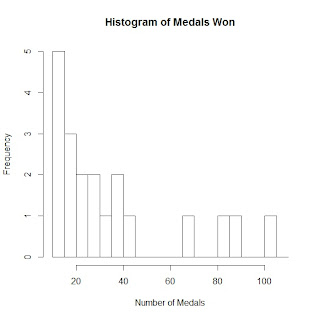Example: The table below lists the number of medals won by country in the 2012 Summer Olympics.
| Country | Number of Medals |
| United States | 104 |
| China | 88 |
| Russia | 82 |
| Great Britain | 65 |
| Germany | 44 |
| Japan | 38 |
| Australia | 35 |
| France | 34 |
| South Korea | 28 |
| Italy | 28 |
| Netherlands | 20 |
| Ukraine | 20 |
| Canada | 18 |
| Hungary | 17 |
| Spain | 17 |
| Cuba | 14 |
| Kazakhstan | 13 |
| New Zealand | 13 |
| Iran | 12 |
| Jamaica | 12 |
First we'll need to create a data set.
> medals = c(104, 88, 82, 65, 44, 38, 35, 34, 28, 28, 20, 20, 18, 17, 17, 14, 13, 13, 12, 12)
Creating a Histogram
Histograms can be quickly created with the hist command.
> hist(medals)
This command generates a histogram from our data, but chooses its own class width. In order to change the number of classes we can include the breaks argument. For instance, instead of the 6 classes R created by default, let's create another histogram from this data with 10 classes.
> hist(medals, breaks = 10)
By setting breaks = 10 we now have a histogram with 10 classes. Unfortunately, using the breaks argument in this fashion is only a suggestion. If we repeat this command with breaks = 12 we will end up with the same graph, and still only 10 classes.
What we need, then, is a way to ensure this command gives us exactly the number of classes we want, along with the appropriate lower and upper class boundaries. To start, let's find the minimum and maximum values in our data set.
> min(medals)
[1] 12
> max(medals)
[1] 104
Since our data values range from 12 to 104 we can choose to construct a histogram that ranges from 10 to 110, with a class width of 5. In order to require R to follow these specific guidelines we will use the seq command to make our breaks a sequence of values from 5 to 110, counting by 5's.
> hist(medals, breaks = seq(10, 110, 5))
We could also choose a class width of 2, 10, 20, or any value that can be equally distributed across the range of values for our histogram.
If we want to add more information to our plot we can include the main and xlab arguments.
> hist(medals, breaks = seq(10, 110, 5), main = "Histogram of Medals Won", xlab = "Number of Medals")
Creating a Frequency Distribution
There is no simple command to create a frequency distribution in R, but we can output the numerical information from the graph by including the argument plot = FALSE.
> hist(medals, breaks = seq(10, 110, 5), plot = FALSE)
$breaks
[1] 10 15 20 25 30 35 40 45 50 55 60 65 70 75 80 85 90 95 100
[20] 105 110
$counts
[1] 5 5 0 2 2 1 1 0 0 0 1 0 0 0 1 1 0 0 1 0
$intensities
[1] 0.05 0.05 0.00 0.02 0.02 0.01 0.01 0.00 0.00 0.00 0.01 0.00 0.00 0.00 0.01
[16] 0.01 0.00 0.00 0.01 0.00
$density
[1] 0.05 0.05 0.00 0.02 0.02 0.01 0.01 0.00 0.00 0.00 0.01 0.00 0.00 0.00 0.01
[16] 0.01 0.00 0.00 0.01 0.00
$mids
[1] 12.5 17.5 22.5 27.5 32.5 37.5 42.5 47.5 52.5 57.5 62.5 67.5
[13] 72.5 77.5 82.5 87.5 92.5 97.5 102.5 107.5
$xname
[1] "medals"
$equidist
[1] TRUE
attr(,"class")
[1] "histogram"
| Class | Frequency |
| (10-15] | 5 |
| (15-20] | 5 |
| (20-25] | 0 |
| (25-30] | 2 |
| (30-35] | 2 |
| (35-40] | 1 |
| (40-45] | 1 |
| (45-50] | 0 |
| (50-55] | 0 |
| (55-60] | 0 |
| (60-65] | 1 |
| (65-70] | 0 |
| (70-75] | 0 |
| (75-80] | 0 |
| (80-85] | 1 |
| (85-90] | 1 |
| (90-95] | 0 |
| (95-100] | 0 |
| (100-105] | 1 |
| (105-110] | 0 |
Left-Closed (Right Open) Intervals
By default, R constructs histograms with class intervals that are right-closed (left open). If instead we wanted class intervals that are left-closed (right open), we can include the argument right = FALSE.
> hist(medals, breaks = seq(10, 110, 5), right = FALSE, main = "Histogram of Medals Won", xlab = "Number of Medals")
> hist(medals, breaks = seq(10, 110, 5), right = FALSE, plot = FALSE)
$breaks
[1] 10 15 20 25 30 35 40 45 50 55 60 65 70 75 80 85 90 95 100
[20] 105 110
$counts
[1] 5 3 2 2 1 2 1 0 0 0 0 1 0 0 1 1 0 0 1 0
$intensities
[1] 0.05 0.03 0.02 0.02 0.01 0.02 0.01 0.00 0.00 0.00 0.00 0.01 0.00 0.00 0.01
[16] 0.01 0.00 0.00 0.01 0.00
$density
[1] 0.05 0.03 0.02 0.02 0.01 0.02 0.01 0.00 0.00 0.00 0.00 0.01 0.00 0.00 0.01
[16] 0.01 0.00 0.00 0.01 0.00
$mids
[1] 12.5 17.5 22.5 27.5 32.5 37.5 42.5 47.5 52.5 57.5 62.5 67.5
[13] 72.5 77.5 82.5 87.5 92.5 97.5 102.5 107.5
$xname
[1] "medals"
$equidist
[1] TRUE
attr(,"class")
[1] "histogram"





No comments:
Post a Comment